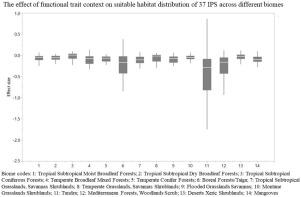Perspectives in Ecology and Conservation ( IF 4.7 ) Pub Date : 2021-08-20 , DOI: 10.1016/j.pecon.2021.07.002 Chun-Jing Wang 1 , Ji-Zhong Wan 1, 2, 3

|
Plant invasion has been proved to threaten biodiversity conservation and ecosystem maintenance at a global scale. It is a challenge to project suitable habitat distributions of invasive plant species (IPS) for invasion risk assessment at large spatial scales. Interaction outcomes between native and invasive plant species are dependent as a function of trait context, which may contribute to suitable habitat distributions of IPS. Here, we explored the effect of functional trait context on suitable habitat distribution of invasive plant species at a global scale. The plant functional trait context was quantified based on the community mean values of specific leaf area, leaf nitrogen concentration, height, and woody density. Habitat suitability modeling was used to project suitable habitat distributions of IPS based on functional trait and abiotic (climate, soil, and human footprint) contexts. There were significant differences in contexts between functional traits and abiotic conditions for IPS across different biomes at a global scale. Community mean functional traits, particularly, height could contribute to habitat suitability of IPS. The functional trait context could have a large effect on the habitat suitability of IPS in Boreal forests/Taiga, Tropical and subtropical grasslands, savannas and shrublands, Tundra, Mediterranean forests, woodlands and scrub, and Mangroves. Functional trait context could affect suitable habitat distributions of IPS at a global scale, indicating that functional trait context should be used as the input for modeling habitat suitability of IPS. The study provided new insights into the application of habitat suitability modeling on plant invasion risk assessment.
中文翻译:

全球尺度入侵植物物种适宜生境分布的功能性状视角
植物入侵已被证明在全球范围内威胁着生物多样性保护和生态系统维护。在大空间尺度上预测入侵植物物种 (IPS) 的合适栖息地分布以进行入侵风险评估是一项挑战。本地和入侵植物物种之间的相互作用结果取决于特征背景,这可能有助于 IPS 的合适栖息地分布。在这里,我们探讨了功能性状背景对全球范围内入侵植物物种适宜栖息地分布的影响。基于特定叶面积、叶氮浓度、高度和木本密度的群落平均值对植物功能性状环境进行量化。栖息地适宜性模型用于根据功能特性和非生物(气候、土壤和人类足迹)背景来预测 IPS 的合适栖息地分布。在全球范围内,不同生物群落中 IPS 的功能性状和非生物条件之间的背景存在显着差异。群落意味着功能特征,特别是高度可能有助于 IPS 的栖息地适宜性。功能特征背景可能对 IPS 在北方森林/针叶林、热带和亚热带草原、稀树草原和灌木地、苔原、地中海森林、林地和灌木丛以及红树林中的栖息地适宜性产生很大影响。功能性状环境可能会影响全球范围内 IPS 的适宜栖息地分布,表明功能特征上下文应用作建模 IPS 栖息地适宜性的输入。该研究为生境适宜性模型在植物入侵风险评估中的应用提供了新的见解。



























 京公网安备 11010802027423号
京公网安备 11010802027423号